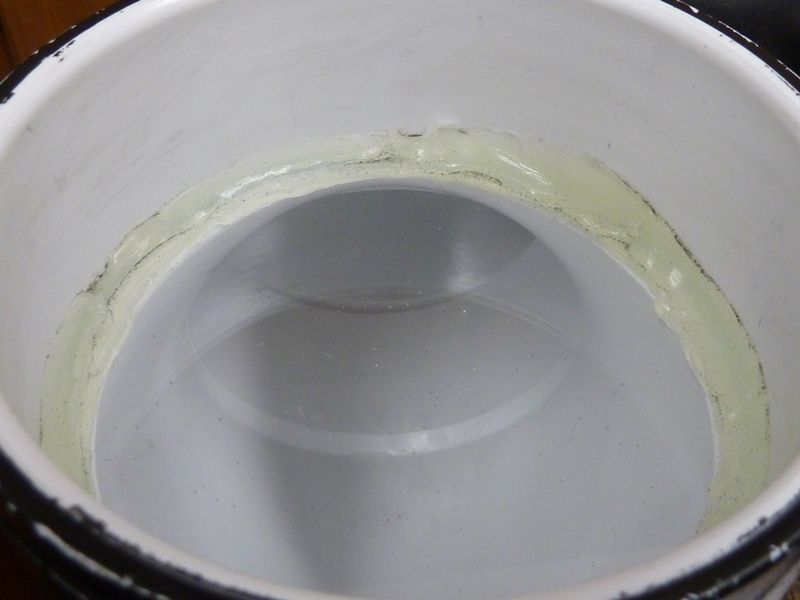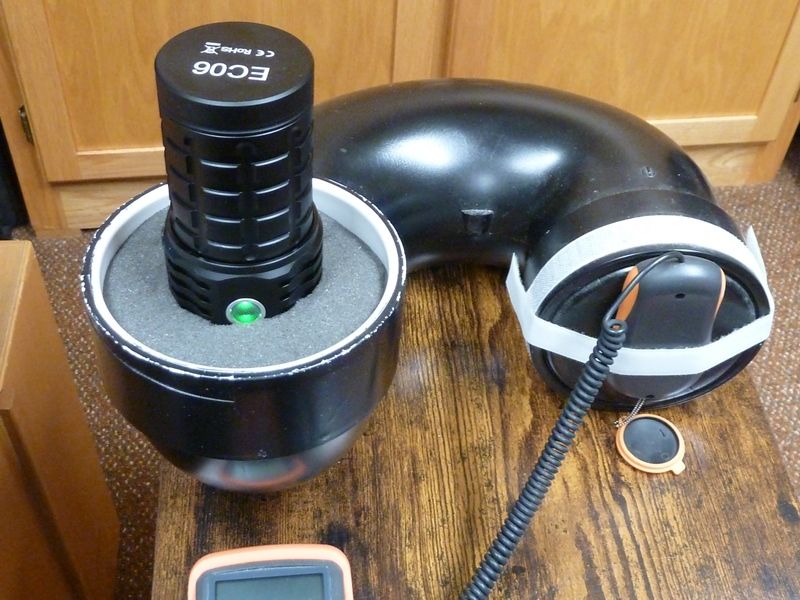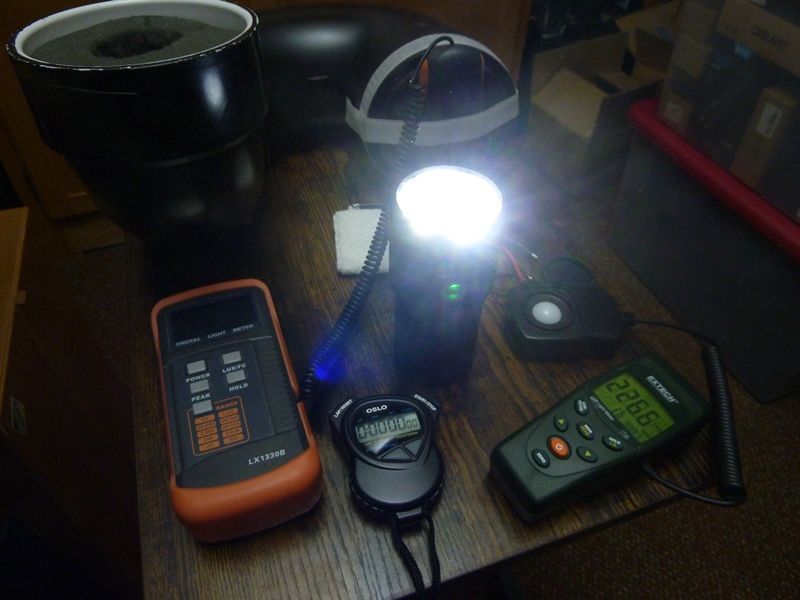Hi Tom_e for GT3 there are different firmware versions. In 1lumen there is your Narsilm firmware and with review of zeroair is late batch of GT3 with Anduril. Anduril have better PID thermal control if I am right compared to Narsilm. I bought from a friend Q8 a few days ago and it was with original Narsilm version of firmware. I tested it for sustained output and thermal protection in Narsilm wil be trigged very soon. I replaced firmware now with Andruril 2 and tested Q8 again. There is big difference with Anduril and output of light compared to Narsilm.
The problem is that zeroair uses forced cooling in its tests. This is an additional variable that only complicates product evaluation. Introduces confusion.
The correct test is to minimize external factors affecting the result.
He's not the only one using cooling - cooling is difficult to standardize, even ambient temperature is a big factor. The problem is people call the EC06 a 700 lumens light now because of one test, one standard. Maybe it is given those parameters. At least zeroair properly configured the thermal calibration, and I believe he's using the cooling to equate it to being held in hand during the duration of the test, but this seems like a guess - not sure if he has test data to back that up.
This is why I don't care for runtime tests - just too arbitrary and mis-leading. Yes, of course the firmware will have an impact, and in the case of Anduril, thermal calibration and the actual thermal configuration compiled in will have an impact, depending on the type of test performed.
There are two types of runtime tests:
- testing of thermal regulation - start at max/turbo or top of ramp and see what it regulates down to
- test a steady level, lower than max, to see how well it maintains output vs. temperature (also can test thermal regulation)
NarsilM doesn't really do thermal regulation - it never brings output back up, only down. It also has 3 modes: OFF, timed, and temperature controlled to lower output. Anduril/A2 uses a PID algorithm to control temperature, but there's other compile time configuration factors as well.
Well, I’m just trying my best to follow ANSI standards for my YouTube review. Not normally do you have a 70°C limit on models that don’t use Anduril. I like to use settings that are friendly for the average user, not us flashaholics that like to play around. I used a 70°C limit for my EA01S review and many weren’t pleased since you can’t actually hold it, so dropped to 50°C and everyone is happy.
My test is in a temp controlled room at 22°C so that helps a lot
Here’s my test

Impossible even, small change of RPM and fan distance can lead to large output difference in PID lights. Active cooling tests are terrible IMO.
Thanks for all the data, Tom and Funtastic. Although the results differ, it gives a good idea of what sustainable output this type of light is capable of.
Funtastic - is the light free standing? I know if I were to do the tests in my PVC tube lightbox against the glass and with tight fitting foam around it, it would bottle up the heat.
So I correlate the lumen readings against the readings from a ceiling bounce and use that for the tests.
I think you are doing the right thing - we, or I don't know what the held in hand factor is though - worse, better or the same compared to free standing.
I would be very much interested in comparing this EC06 to a compact triple XHP70.2 light, same test setup. Lights like the Lumintop GT3 or MT03 TA are very close in size and output, and they can run Anduril 2 as well. It's a shame after all this time we still can't get a copy of the actual Anduril/2 source code used in the manufactured lights. In fact the A2 lights, even from Hank, that have a link to the source code, the link points to old Anduril. His latest DM11 here: https://intl-outdoor.com/noctigon-dm11-1-21700-middle-range-thrower.html -- source code link is worthless!
Again, the actual source code used (specific cfg file) is important since it contains the compile time thermal config settings.
To test the 3V vs. 12V thermally, the new DM11 with a SST-40 and one with a XHP35-HI would be the perfect pair to check. Both produce about the same lumens output, about the same amps, one using a boost driver, the other using a CC regulated FET (maybe??).
Ah, that’s interesting, I had never thought of the heat rising from the tube or projected back from the diffusing disc.
Well, I’m not making more runtime tests, so guess I’ll just use it on my review. How should I make graphs without the tube? Maybe a shoe box? I can’t just sit it in a dark room since it needs monitioring
I just have it sitting on those discs TA made that came with the tube.
I’ll do another turbo run with it free standing for 20 min and report
Ohh, not familiar with the discs. I would think heat reflecting off of them would come back to the head of the light. I have an original lightbox, made by an early BLFer who made a couple of them, including Dale's (DB Custom), down in Texas. We put the flashlight directly on the glass that is siliconed into the tube, then use a round gray foam with the center cut out in various sizes to seal up the rest of the opening.
What I did was select a mode level I wanted to test, measured it's lumens output in the PVC lightbox, then tail-standed the light at the same output level on a table, next to the ExTech LT45 and used it to ceiling bounce test the output - probably not perfect but a ceiling bounce setup follows the lightbox fairly well. Then you can sync up the lumens to the ceiling bounce readings of the meter. You could experiment with various lumens levesl if you like to test/prove the ceiling bounce method, maybe refine the calibration a bit.
With my foam setup, it's a heat trap for sure and couldn't use it for anything longer than 30 secs probably.


Here's my setup:
for the runtime tests, this is the setup but with the room lights off so only light source is the flashlight:
Tested free standing with the same settings and same result.
Testing aside, I went for a walk last night on lvl 5 for 20 or so minutes, chucked it on the lumen tube and it was happily at 1700. That wasn’t too bad, but I really don’t enjoy walking for too long with this much weight, I still use my BLF A6 with SST40 5000K
Does anyone know if/how the firmware can be updated through those pads on the driver? Will it be as easy as Hank’s lights where you just reflash right from TK’s repository?
Well yes and no - I believe you can reflash through those pads, but no - not as easy as Hank's lights because there's no off the shelf flash adapter made for this light, and Hank works with TK for TK to have a sample light to configure and test, and therefore support with a .HEX file update.
I tried to determine what A2 version this light is flashed with but the version info didn't make sense to me - not sure if I am interpreting it correctly. I suspect it's a pretty recent version though, but not sure. All of TK's most recent changes have been for tint ramping lights, not relative to this light. I'll try further to identify it before I upgrade it myself using the ATTiny85 clip adapter - easy to access the MCU, removing 2 screws gives access to the driver and MCU.
It is possible to use same Anduril2 version same as Q8 Pro?
Hhmm, think so - think it's the same pinouts. Not sure if smooth ramping will look ok switching from the 7135's to the FET's because the 3 7135's is brighter than 1 7135 -- might be ok, might depend on how fussy you are.
Thanks for the review and tear down ![]()
Should I get the Samsun 30T or 40T for maximum performance?




